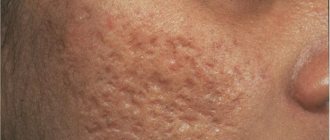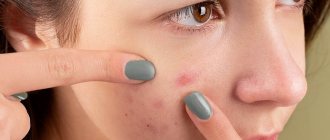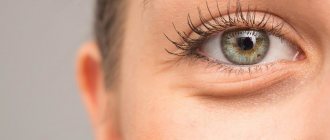Indications for use of ointments
Not all drugs are universal, so you should consult a dermatologist before using the ointment. If the ointment is used incorrectly, the skin condition may worsen. General indications for the use of anti-scar ointments are:
- stretch marks caused by weight gain or sudden loss;
- post-traumatic tendon contractures;
- prevention of scarring after surgery;
- keloid (colloid) scars;
- atrophic and normotrophic scars;
- hyperpigmentation and post-acne;
- fresh hypertrophic scars.
Ointments are used to treat any areas of the body, including the face, where scars are most annoying. Treatment of cosmetic defects is complex. Peels, laser resurfacing and the use of creams and ointments at home are often required. The full scope of procedures is determined by the nature of origin and age of the scars.
Classification of postoperative scars
Scars after surgery are divided into the following types:
- normotrophic;
- atrophic;
- hypertrophic;
- keloid.
Normotrophic scars are characterized by a pale color and are located flush with the skin. They are usually unnoticeable to others.
Atrophic scars appear in areas of inflammatory processes. They can be pale or pink in color, characterized by increased laxity and at a level lower than the surrounding tissue. The reason for the appearance of such scars is a violation of collagen production in the skin.
Hypertrophic and keloid scars are characterized by the fact that they extend beyond the boundaries of the skin. They can grow over time and are difficult to treat. The color may be pink, red or bluish. They are dense, lumpy and painful.
Review of anti-scar medications
It is safer to entrust the choice of a remedy to a doctor, especially after the appearance of surgical scars - with appendicitis, hernia, etc. Thus, retinoic ointment is effective for acne and post-acne, but in the case of traumatic scars it is powerless. The silicone-based drug "Strataderm" copes with scars and scars, eliminates stretch marks, but is expensive. Moreover, one tube is not enough to carry out a treatment course.
Let's consider a list of popular products for scars that are effective and do not put a strain on the family budget.
| Name of ointment | Action | Mode of application |
| Contractubex | The German drug contains heparin and allantoin. These components help break down scar tissue and improve regeneration. The drug has a positive effect on the skin structure, softens pathological tissue and makes the epidermis elastic. The ointment contains onion extract. This ingredient has an anti-inflammatory effect, improves blood microcirculation and inhibits the proliferation of connective tissue. | Contractubex is applied to the affected area three times a day for a month. The drug is prescribed at the early stage of scarring and for prevention. The drug is ineffective against old scars. |
| Dermatix | A Dutch-made drug in the form of a gel-like mass. It is used immediately after the wound has healed to prevent scarring. The product eliminates pigmentation, improves blood supply to epidermal cells, and saturates the connective tissue with moisture. | Dermatix is applied twice daily. The drug is quickly absorbed and leaves no traces. Duration of therapy is 2 months. The drug will not help with deep skin damage. But it is safe and suitable for use by children and pregnant women. |
| Fermenkol | Active collagen preparation made in Russia. Stimulates the resorption of existing scars and prevents new ones. Makes convex formations flat and elastic. At the same time it has an analgesic and antipruritic effect. Side effects to the ointment are rare, so the product is recommended for use in children. | Use the product twice a day for a month. Fermenkol removes hypertrophic scars on the body. To increase the effectiveness of therapy, the drug is used as part of medicinal electrophoresis. |
| Solcoseryl | The drug improves cell regeneration and nutrition. It is applied to the face for acne and post-acne. The ointment will be useful for dry wounds, frostbite, burns, and cuts. Zinc ointment works similarly. It is cheaper and suitable for the treatment of dermatitis, bedsores, dry and weeping wounds. Both drugs do not have a pronounced anti-scar effect. But using them early will prevent scarring. | The ointment should be used twice a day. At the stage of scar formation, the drug is used under a bandage. |
| Clearvin | This cream softens the skin, activates cellular metabolism, and improves blood circulation. Contains natural ingredients and belongs to Ayurvedic preparations. Effective against comedones, stretch marks, age spots, skin microdamages. Suitable for treating acne, smoothes the skin, eliminates signs of chronic fatigue. | The skin is lubricated morning and evening for several weeks. Doctors consider the drug as a cosmetic product, but the natural base and safety of the cream distinguish it from other drugs. For minor disorders and for their prevention, the product will be effective. |
| Imoferase | The cream is intended directly for the removal of scars and scars. Hyaluronidase, which is part of the cream, inhibits the growth of connective tissue and reduces swelling. During a course of treatment, convex formations decrease in volume, the level of pigmentation decreases, and elasticity increases. Imoferase cream acts on old scars and scars, reducing their density. | The effect of treatment is noticeable after 3 weeks, the full course of therapy is 8 weeks. It is recommended to use the cream after operations, burns, cesarean section and in case of traumatic skin damage. |
| Heparin ointment | The drug improves blood microcirculation, which allows it to be used for stretch marks, hematomas, localized infiltrates and ulcerative lesions. It will not be possible to get rid of scars with heparin ointment, but prophylactic use of the product will prevent pathological growth of connective tissue. | Heparin ointment is applied up to 3 times a day for 2 weeks. |
| Methyluracil | Forces regenerative processes, improves renewal of epidermal cells. The ointment heals wounds by speeding up epithelization. It has a protective property, restores the integrity of the skin, and prevents degenerative changes in the epidermis. Used after burns, including radiation. Bepanten cream works in a similar way. The list of indications for the drugs is comparable. | The duration of therapy is 1-4 months. An analogue of the drug is called Levomekol ointment. This is a combination drug based on methyluracil. |
| Vishnevsky | The ointment resolves seals and activates restoration processes. The drug is distinguished by its dark color, pungent odor, and affordable price. The drug is not able to get rid of scars and rough scars. But it is used to eliminate the consequences of chickenpox, acne, and dermatological diseases. Compresses with Vishnevsky ointment are effective. | The drug is mixed with honey in equal proportions, applied to the skin, covered with a cabbage leaf, then with film and left for an hour. Ichthyol ointment works in a similar way. |
| Hydrocortisone | The ointment has anti-inflammatory properties and inhibits the growth of connective tissue. It is used after blepharoplasty and eyelid pathology. Hydrocortisone ointment is a glucocorticosteroid, which explains the impressive list of contraindications and side effects. | The ointment is used for 2 weeks, treating the skin surface up to 4 times daily. |
"Anti-scar" - promotes collagen production
The gel reduces scarring of the skin after wounds, burns, surgeries, acne, and stretch marks on the body. Anti-scar ointment based on Mg improves collagen synthesis and thereby changes the structure of the scar, promoting its disappearance. The drug has additional effects: softens the skin, increases its elasticity, reduces wrinkles on the face and resolves scars and stretch marks.
Directions for use: Apply a small amount of gel with massaging movements to problem areas of the body 2 times a day. The minimum course of treatment is 2 weeks.
Kelo-cote – treatment of scars after surgical interventions
The gel was produced by the American company Advanced Bio-Techologies using a unique technology. Its main purpose is the prevention and treatment of scars after surgery. Fights against such types of scars: keloid, hypertrophic, atrophic and others. It is safe to use, therefore it is prescribed to both adults and children.
Apply Kelo-Coat to dry skin morning and evening for 60-90 days. Within 2 months the results will be noticeable: itching, pain, inflammation and tightness on the skin will disappear. Also used to heal wounds and scratches.
“Rescuer” - helps with burn scars
If you receive household burns, it is recommended to apply Rescuer in a thin layer to the affected area of the skin. The ointment cleans the injured surface, disinfects it and promotes rapid wound healing, preventing the appearance of scars. Rescuer ointment is not hormonal, so it is not addictive.
The drug can also be used to treat sunburn. It soothes the skin, reduces redness and promotes rapid healing.
Complications of postoperative scars
Various complications can worsen the condition of scars after surgery:
- granuloma;
- ligature abscess;
- seroma;
- hematoma;
- infiltrate.
Treatment of these complications is carried out in medical institutions. For this, conservative methods or surgical intervention can be used.
Scar granuloma after surgery can occur if starch or talc from surgeons' gloves gets into the wound during surgery. This complication can also occur if the suture material is not completely absorbed. The development of this complication can be prevented by using self-absorbable suture material and strict adherence to all aseptic rules. Treatment of postoperative scar granuloma consists of excision of the connective tissue in which the granulomas are located. At the same time, all remaining fragments of suture material are removed.
A ligature abscess is accompanied by suppuration around the threads and the formation of a fistula. In order to cure this complication, the surgeon makes an incision through which the pus is removed and the remaining suture material is removed.
Seroma is an accumulation of lymph, which is provoked by damage to the lymphatic vessels and capillaries, as well as surrounding tissues. This complication is treated by puncture of fluid from the seroma (several procedures may be required).
A hematoma can occur because the patient has diseases that affect blood clotting, or if his blood pressure has risen too much after surgery. A hematoma is characterized by redness or blueness of the skin, pain, and swelling. Most often, hematomas go away on their own, but in some cases, excess fluid from the scar is pumped out through a needle.
Infiltration is the accumulation of fluid and pus in the area of the postoperative scar. This complication is accompanied by swelling and inflammation, high body temperature, and aching pain. This leads to a significant slowdown in the wound healing process and can cause an abscess. Treatment uses antibacterial therapy, as well as physiotherapy methods and novocaine blockade. If conservative methods do not help, an operation is performed: the abscess is opened and the pus is removed from it.
Contraindications
The main contraindication to the use of the presented drugs is individual intolerance. Silicone preparations are hypoallergenic, and ointments based on plant extracts are used after an allergy test.
Contraindications and side effects vary depending on the type of drug. Glucocorticosteroids are prohibited during pregnancy and lactation. They remove pathological formations well, but are not used in childhood and for kidney diseases.
If it is not possible to cope with scars using external preparations, then lidase injections are used. Procedures are carried out daily or every other day. One procedure requires an ampoule of lidase.
A dermatologist can select an effective and safe drug based on the clinical picture. Positive results are obtained from complex treatment using ointments and physiotherapy.
Reviews
Anna: I used Fermenkol gel after prolonged acne. There were dents and cyanosis on the face. I conducted two courses with an interval of a month. There were no marks left on the skin.
Victor: I was treated by a dermatologist when I scalded my hand. The burns have healed, but the scars remain. The doctor said that I started treatment on time. After just a year, it would be difficult to remove traces. Contractubex helped. I smeared it for a month.
Olga: I’m not ready to overpay for pharmaceutical anti-scar products when the problem can be dealt with in affordable ways. I use a vodka compress with Vishnevsky ointment. It warms and heals. Helps with minor defects.










